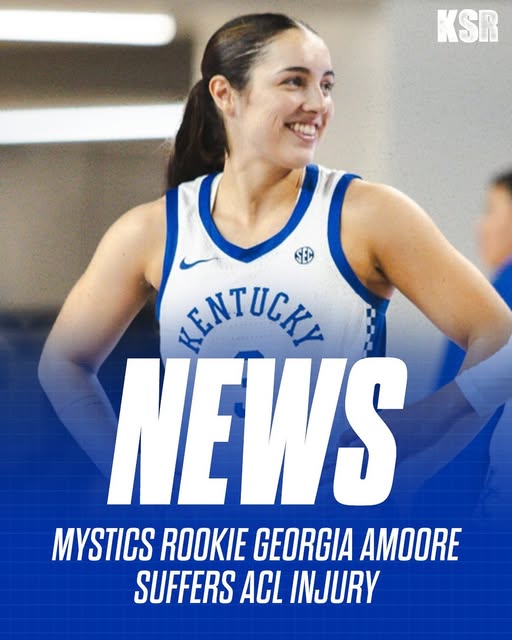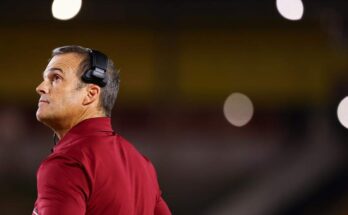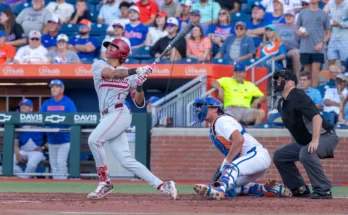The Washington Mystics have been dealt a major blow just ahead of the WNBA season as the team announced that rookie guard Georgia Amoore suffered an anterior cruciate ligament (ACL) injury during Tuesday’s practice. The unfortunate incident occurred during a routine training session, and early evaluations have confirmed the severity of the injury. This development not only casts a shadow over the Mystics’ upcoming season but also marks a heartbreaking turn in what was poised to be a promising rookie year for Amoore, one of the most exciting prospects in this year’s WNBA draft class.
Georgia Amoore, a dynamic and skilled guard out of Virginia Tech, was selected by the Washington Mystics with high hopes and expectations. Her college career had been nothing short of impressive, featuring standout performances, strong leadership qualities, and a deep understanding of the game. Throughout her time in the NCAA, she consistently demonstrated the ability to impact games both as a scorer and a playmaker, traits that made her an ideal fit for the professional ranks.
The news of her injury sent ripples across the WNBA community, eliciting reactions from teammates, coaches, analysts, and fans alike. For a young player just on the cusp of launching her professional journey, an ACL tear is a difficult and emotionally taxing hurdle. The ACL, a critical ligament in the knee, plays a central role in stability and mobility, particularly in a sport that demands explosive movement, quick directional changes, and persistent physical strain. Recovery from such an injury typically involves surgical reconstruction followed by an extensive rehabilitation process that can take 9 to 12 months or longer, depending on the individual and the demands of their position.
For the Mystics, who have been working to retool their roster and return to championship contention, the injury is particularly untimely. Amoore was projected to bring a new level of energy and creativity to the backcourt. Her agility, court vision, and scoring instincts were expected to add depth and versatility to Washington’s offense. While she may have needed time to adjust to the speed and physicality of the professional game, her learning curve was expected to be short given her basketball IQ and work ethic.
This injury now shifts the trajectory of her rookie season from a year of growth and exposure to one of recovery and resilience. The Mystics, for their part, have expressed full support for Amoore during this difficult time. In a statement released by the team, Head Coach Eric Thibault emphasized their commitment to her recovery and overall well-being, noting that she remains an important part of their long-term vision. “Georgia is a special talent, and this is an unfortunate setback,” said Thibault. “But we know how strong she is mentally and physically. She’s going to attack this recovery with the same intensity she brings to the court every day.”
Amoore’s collegiate resume at Virginia Tech was full of highlights. As the leading guard for the Hokies, she averaged double-digit points and was known for her fearless drives to the basket, mid-range accuracy, and clutch play in pressure situations. She played a crucial role in guiding Virginia Tech to deep postseason runs, showcasing her leadership both on and off the court. Her transition to the WNBA was highly anticipated, and fans were eager to see how her style would translate at the next level.
Injuries are an unfortunate reality of sports, particularly in leagues as competitive as the WNBA. ACL injuries, in particular, have affected many high-profile players over the years. While the path to recovery is long and often arduous, advances in medical treatment and physical therapy have made it possible for many athletes to return to peak form post-surgery. Examples abound of WNBA stars who have returned stronger after similar injuries, using the rehabilitation process to not only rebuild their bodies but also deepen their understanding of the game.
Amoore’s journey from here will likely begin with surgery, followed by an intensive rehabilitation regimen supervised by the Mystics’ medical staff and physical therapists. The focus will initially be on regaining knee stability, followed by strength building, and eventually sport-specific training to prepare her for a full return to competition. Throughout this process, mental health support will be crucial, as the psychological toll of a season-ending injury can be just as significant as the physical one.
Her teammates have already voiced their support on social media and in interviews. Several veteran players spoke to the importance of rallying around injured teammates, both in terms of morale and ensuring they remain part of the team culture even when they aren’t on the court. “She’s one of us, and we’ve got her back,” said one of the Mystics’ senior players. “It’s tough, no doubt, but Georgia is tough too. She’s going to get through this, and we’ll be there every step of the way.”
The impact of her absence will be felt on the court, as the Mystics will now have to adjust their rotation and game planning without the fresh spark she was expected to provide. The coaching staff may look toward veteran players or undrafted talent to step into the role Amoore was expected to fill. Still, the longer-term implications are significant, as Amoore was seen as a foundational piece for the franchise moving forward.
From a fan perspective, the injury is a bitter disappointment. The excitement surrounding Amoore’s entry into the WNBA had generated buzz in both Washington and among followers of women’s college basketball. Her fans from Virginia Tech had already begun showing support in her new colors, and her preseason workouts had drawn praise from coaches and analysts for her poise and tenacity. The idea of seeing a young player like Amoore blossom into a star in the nation’s capital was compelling, and her injury delays that vision.
However, sports are as much about overcoming adversity as they are about achieving victory. Georgia Amoore’s story is now one of resilience. This chapter, though not the one anyone hoped for, will test her in new ways and ultimately contribute to her growth as both an athlete and a person. Many of the greatest stories in basketball are shaped not by flawless trajectories but by how players respond to hardship. Amoore, known for her determination and strong mindset, seems well-equipped to handle what lies ahead.
In the meantime, the Mystics will forge ahead into the season without her, with the hope that they can still build momentum and develop team chemistry. They will keep a space open for her return, both symbolically and strategically. For now, fans will wait and hope for positive updates, tracking her recovery progress and looking forward to the day when she can finally make her WNBA debut.
Georgia Amoore may not get the rookie season she dreamed of, but her story in the WNBA is far from over. The passion, talent, and resolve that got her to this point will continue to drive her forward. In time, she will return, and when she does, the league will undoubtedly be watching. Her journey—temporarily paused—will resume with even more meaning and purpose.



